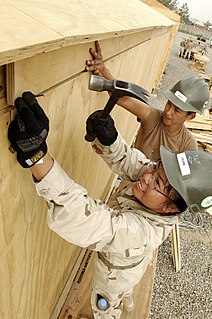
Industrial and organizational psychology, an applied discipline within psychology, is the science of human behavior as it pertains to the workplace. Depending on the country or region of the world, I-O psychology is also known as occupational psychology in the United Kingdom, organizational psychology in Australia and New Zealand, and work and organizational (WO) psychology throughout Europe and Brazil. Industrial, work, and organizational psychology (IWO) psychology is the broader, more global term for the science and profession.

Training is teaching, or developing in oneself or others, any skills and knowledge or fitness that relate to specific useful competencies. Training has specific goals of improving one's capability, capacity, productivity and performance. It forms the core of apprenticeships and provides the backbone of content at institutes of technology. In addition to the basic training required for a trade, occupation or profession, training may continue beyond initial competence to maintain, upgrade and update skills throughout working life. People within some professions and occupations may refer to this sort of training as professional development. Training also refers to the development of physical fitness related to a specific competence, such as sport, martial arts, military applications and some other occupations.
The Occupational Safety and Health Administration is a large regulatory agency of the United States Department of Labor that originally had federal visitorial powers to inspect and examine workplaces. Congress established the agency under the Occupational Safety and Health Act, which President Richard M. Nixon signed into law on December 29, 1970. OSHA's mission is to "assure safe and healthy working conditions for working men and women by setting and enforcing standards and by providing training, outreach, education and assistance". The agency is also charged with enforcing a variety of whistleblower statutes and regulations. OSHA's workplace safety inspections have been shown to reduce injury rates and injury costs without adverse effects to employment, sales, credit ratings or firm survival.

Safety is the state of being "safe", the condition of being protected from harm or other danger. Safety can also refer to the control of recognized hazards in order to achieve an acceptable level of risk.

Occupational hygiene is the anticipation, recognition, evaluation, control, and confirmation of protection from hazards at work that may result in injury, illness, or affect the well being of workers. These hazards or stressors are typically divided into the categories biological, chemical, physical, ergonomic and psychosocial. The risk of a health effect from a given stressor is a function of the hazard multiplied by the exposure to the individual or group. For chemicals, the hazard can be understood by the dose response profile most often based on toxicological studies or models. Occupational hygienists work closely with toxicologists for understanding chemical hazards, physicists for physical hazards, and physicians and microbiologists for biological hazards Environmental and occupational hygienists are considered experts in exposure science and exposure risk management. Depending on an individual's type of job, a hygienist will apply their exposure science expertise for the protection of workers, consumers and/or communities.

Job analysis is a family of procedures to identify the content of a job in terms of the activities it involves in addition to the attributes or requirements necessary to perform those activities. Job analysis provides information to organizations that helps them determine which employees are best fit for specific jobs.

A supervisor, or lead, is the job title of a lower-level management position that is primarily based on authority over workers or workplace. A supervisor can also be one of the most senior in the staff at the place of work, such as a professor who oversees a PhD dissertation. Supervision, on the other hand, can be performed by people without this formal title, for example by parents. The term supervisor itself can be used to refer to any personnel who have this task as part of their job description.

Lock out, tag out (LOTO) is a safety procedure used in industry and research settings to ensure that dangerous machines are properly shut off and not able to be started up again prior to the completion of maintenance or repair work. It requires that hazardous energy sources be "isolated and rendered inoperative" before work is started on the equipment in question. The isolated power sources are then locked and a tag is placed on the lock identifying the worker who placed it. The worker then holds the key for the lock, ensuring that only he or she can remove the lock and start the machine. This prevents accidental startup of a machine while it is in a hazardous state or while a worker is in direct contact with it.
A standard operating procedure (SOP) is a set of step-by-step instructions compiled by an organization to help workers carry out routine operations. SOPs aim to achieve efficiency, quality output and uniformity of performance, while reducing miscommunication and failure to comply with industry regulations.
On-the-job training is an important topic of human resource management. It helps develop the career of the individual and the prosperous growth of the organization. On the job training is a form of training provided at the workplace. During the training, employees are familiarized with the working environment they will become part of. Employees also get a hands-on experience using machinery, equipment, tools, materials, etc. Part of on-the-job training is to face the challenges that occur during the performance of the job. An experienced employee or a manager are executing the role of the mentor who through written, or verbal instructions and demonstrations are passing on his/her knowledge and company-specific skills to the new employee. Executing the training on at the job location, rather than the classroom, creates a stress-free environment for the employees. On-the-job training is the most popular method of training not only in the United States but in most of the developed countries, such as the United Kingdom, Canada, Australia, etc. Its effectiveness is based on the use of existing workplace tools, machines, documents and equipment, and the knowledge of specialists who are working in this field. On-the-job training is easy to arrange and manage and it simplifies the process of adapting to the new workplace. On-the-job training is highly used for practical tasks. It is inexpensive, and it doesn't require special equipment that is normally used for a specific job. Upon satisfaction of completion of the training, the employer is expected to retain participants as regular employees.
Manual handling of loads (MHL), manual material handling (MMH) involves the use of the human body to lift, lower, carry or transfer loads. The average person is exposed to manual lifting of loads in the work place, in recreational atmospheres, and even in the home. To properly protect one from injuring themselves, it is important to first understand general body mechanics.
A job safety analysis (JSA) is a procedure which helps integrate accepted safety and health principles and practices into a particular task or job operation. In a JSA, each basic step of the job is to identify potential hazards and to recommend the safest way to do the job. Other terms used to describe this procedure are job hazard analysis (JHA) and job hazard breakdown.
The term safe work procedure (SWP) originated in Victoria, Australia, and is predominantly used as a risk management tool by industries throughout Australia, particularly in the mining sector. SWPs are also referred to using other terms, such as standard operating procedure (SOP). A safe work procedure is a step by step description of a process when deviation may cause a loss. This risk control document created by teams within the company describes the safest and most efficient way to perform a task. This document stays in the health & safety system for regular use as a template or guide when completing that particular task on site.
An occupational fatality is a death that occurs while a person is at work or performing work related tasks. Occupational fatalities are also commonly called “occupational deaths” or “work-related deaths/fatalities” and can occur in any industry or occupation.

A physical hazard is an agent, factor or circumstance that can cause harm with contact. They can be classified as type of occupational hazard or environmental hazard. Physical hazards include ergonomic hazards, radiation, heat and cold stress, vibration hazards, and noise hazards. Engineering controls are often used to mitigate physical hazards.
Positive psychology is defined as a method of building on what is good and what is already working instead of attempting to stimulate improvement by focusing on the weak links in an individual, a group, or in this case, a company. Implementing positive psychology in the workplace means creating an environment that is more enjoyable, productive, and values individual employees. This also means creating a work schedule that does not lead to emotional and physical distress.

Occupational safety and health (OSH), also commonly referred to as occupational health and safety (OHS), occupational health, or occupational safety, is a multidisciplinary field concerned with the safety, health, and welfare of people at occupation. These terms also refer to the goals of this field, so their use in the sense of this article was originally an abbreviation of occupational safety and health program/department etc.

Hierarchy of hazard control is a system used in industry to minimize or eliminate exposure to hazards. It is a widely accepted system promoted by numerous safety organizations. This concept is taught to managers in industry, to be promoted as standard practice in the workplace. It has also been used to inform public policy, in fields such as road safety. Various illustrations are used to depict this system, most commonly a triangle.

Human factors and ergonomics is the application of psychological and physiological principles to the engineering and design of products, processes, and systems. Four primary goals of human factors learning are to reduce human error, increase productivity, and enhance safety, system availability and comfort with a specific focus on the interaction between the human and the engineered system.
Engineering controls are strategies designed to protect workers from hazardous conditions by placing a barrier between the worker and the hazard or by removing a hazardous substance through air ventilation. Engineering controls involve a physical change to the workplace itself, rather than relying on workers' behavior or requiring workers to wear protective clothing.